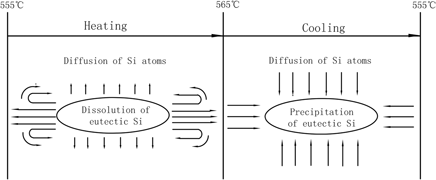Crossref Citations
This article has been cited by the following publications. This list is generated based on data provided by
Crossref.
Jin, L.
Liu, K.
and
Chen, X.-G.
2020.
Improved Elevated Temperature Properties in Al-13%Si Piston Alloys by Mo Addition.
Journal of Materials Engineering and Performance,
Vol. 29,
Issue. 1,
p.
126.
Santos, Silvano Leal dos
Toloczko, Felipe Ribeiro
Merij, Abrão Chiaranda
Saito, Newton Haruo
and
Silva, Davinson Mariano da
2021.
Investigation and Nanomechanical Behavior of the Microconstituents of Al-Si-Cu alloy After Solution and Ageing Heat Treatments.
Materials Research,
Vol. 24,
Issue. 2,
Basak, Surajit
Biswas, Prosanta
Patra, Surajit
Roy, Himadri
and
Mondal, Manas Kumar
2021.
Effect of TiB2 and Al3Ti on the microstructure, mechanical properties and fracture behaviour of near eutectic Al-12.6Si alloy.
International Journal of Minerals, Metallurgy and Materials,
Vol. 28,
Issue. 7,
p.
1174.
An, Seongbin
Kim, Minsuk
Huh, Chaeeul
and
Kim, Chungseok
2021.
Microstructure and Mechanical Property of Al6Si2Cu Alloy Subjected to Double-Solution Heat Treatment.
Metals,
Vol. 12,
Issue. 1,
p.
18.
Teng, Da
Zhang, Guangzong
Zhang, Shuo
Li, Junwen
and
Guan, Renguo
2023.
Mechanical Properties of Refined A356 Alloy in Response to Continuous Rheological Extruded Al-5Ti-0.6C-1.0Ce Alloy Prepared at Different Temperatures.
Metals,
Vol. 13,
Issue. 8,
p.
1344.
Valencia de Lima, José Ivan
García Pastor, Francisco Alfredo
and
Flores Valdés, Alfredo
2023.
The Effect of Heat Treating and Deformation by Rolling and Forging on the Mechanical Properties of the 4032-Type Alloy Prepared from Recycled Materials.
Metals,
Vol. 13,
Issue. 9,
p.
1515.
Wang, Y. F.
Zhou, H.
Wang, J. H.
Liu, Y.
Tu, H.
and
Su, X. P.
2023.
Effect of Annealing on Microstructure and Mechanical Properties of Al–18Si Alloy Cast by Melt Quenching.
Physics of Metals and Metallography,
Vol. 124,
Issue. 14,
p.
1856.
Karamouz, Mostafa
and
Jesmani, Seyed Mohammad
2024.
Influence of Be Content and T4 Temper Heat Treatment on Hardness and Wear Behavior of Al-Alloy A319.
Journal of Materials Engineering and Performance,
Liu, Hao
Hu, Wenru
Pang, Yafei
Qiu, Mingkun
and
Du, Xiaodong
2024.
Effects of Cu Addition and Spheroidization Treatment on Microstructure and Mechanical Properties of Al–Si–Cu–Mg–Ti–Zr–Sr Alloys.
International Journal of Metalcasting,
Vol. 18,
Issue. 2,
p.
1401.
Mahmoud Kalayeh, Parastoo
Mirzadeh, Hamed
Malekan, Mehdi
Emamy, Massoud
and
Mahmudi, Reza
2024.
Improved hardness of Mg-0.5Ni-xY alloys via grain refinement and formation of LPSO structures.
Journal of Materials Research and Technology,
Vol. 30,
Issue. ,
p.
6829.
Krall, Patrick
Weißensteiner, Irmgard
and
Pogatscher, Stefan
2024.
Recycling aluminum alloys for the automotive industry: Breaking the source-sink paradigm.
Resources, Conservation and Recycling,
Vol. 202,
Issue. ,
p.
107370.
Krall, Patrick
and
Pogatscher, Stefan
2024.
Light Metals 2024.
p.
191.
An, Linbo
Du, Xiaodong
Kong, Jinlong
and
Zheng, Jiale
2025.
Effect of Annealing on Microstructure and Properties of Al–Si–Mg–Cu–B–P Alloy.
Transactions of the Indian Institute of Metals,
Vol. 78,
Issue. 3,




